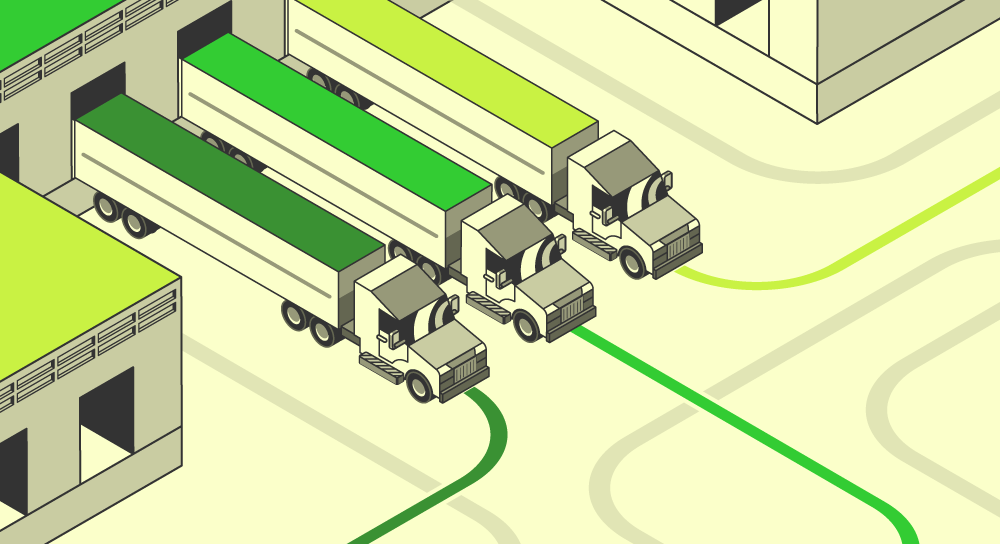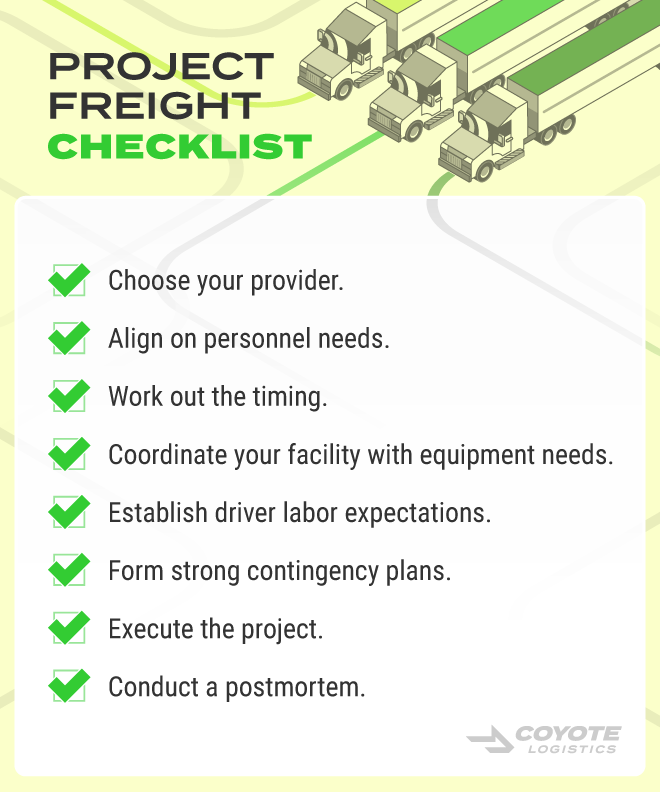Your Step-By-Step Project Freight Guide (Use This Checklist)
Do any of these scenarios sound familiar?
- Spiking customer demand that means your freight network can’t keep up.
- Seasonal surges that strain your network and overfill your warehouses.
- Promotional launches that require an unusual level of coordination.
- Facility or warehouse moves that need to go off fast and fully without disrupting operations.
You have a shipping project on your hands, and you need to find the right transportation provider to handle it.
Learn about the most common types of project freight, and be sure to refer to the checklist when planning your next big move.
Article Overview
- Project freight, defined
- Common types of project freight
- 8-step project freight checklist
- Project freight mistakes to avoid
- The case for shipping project freight with a 3PL
When we talk about project freight (also called shipping projects), we’re referring to a group of shipments that:
- Move in a short timespan
- Require additional planning
- Demand high service levels
- Involve more and/or different carrier capacity than is typical
Common examples include facility moves, peak season surges and promotional product launches.
Larger shippers who have their own private or dedicated fleets may be able to flex some of this capacity to handle special projects.
But if you can’t use your fleet — or don’t have one — you need to find a provider who can handle it.
These moves take careful coordination by multiple parties to procure all the necessary capacity, orchestrate the logistics, and everyone operating in unison.
Project Freight vs. Project Cargo
“Project freight” is not to be confused with “project cargo”. Project cargo generally refers to individual shipments of large, bulky, often high-value freight.
Project cargo does not ship with standard trucking equipment. It is usually shipped via waterway (ship or barge), rail or heavy haul or oversized open deck trucking.
Project cargo can be a part of a wider shipping project (for example, moving an oversized piece of machinery as part of a whole factory move), but they are not the same thing.
Common Project Freight Scenarios
Surge Capacity
Many businesses are seasonal, with demand spiking during certain times of the year. While these cycles may be predictable, the freight volume spikes caused by them rarely are.
In the retail industry, the biggest annual surge takes place before the end-of-year holidays and is known as “peak season.” Other industries may have different surge cycles — produce shippers have peaks throughout the year in different parts of the country, for instance.
For these busier seasons, shippers need extra capacity on hand and on call outside their normal procurement. While this can mean more standard truckload capacity, many shippers utilize power-only and drop-and-hook solutions to keep freight moving faster.
Mobile Warehousing
Sometimes, you just need more places to put all your stuff.
Maybe you’re ramping up inventory in anticipation of your annual peak, or maybe your business is just growing faster than your facility can keep up.
Whatever the reason, a common form of project freight is mobile warehousing. Providers with trailer assets can drop them off at your facility for an agreed-upon length of time to provide additional storage capacity.
Facility Moves
This is the type of project freight that looks the most like “a project.”
Moving into a new warehouse or factory is an incredibly complex process — made even more so by the fact that you probably don’t want to interrupt your operations to do it.
These moves can require months of planning to ensure your plan is airtight enough to guarantee success and help you get total organizational buy-in.
In the lead up to the project’s execution, you’ll want to create comprehensive lists of personnel — both your own and your freight provider’s — who will be on the ground to facilitate the move.
You also need to know exactly what equipment will be required (dry van, refrigerated, open-deck — everything) to move your freight in coordination.
And it’s not enough to check each of these boxes once. You also will want to have viable backup options in place to prevent any staff shortage or equipment failures from jeopardizing the project.
Expedited Shipping
While generally lower-volume than most of the scenarios mentioned above, expedited freight is also a kind of project for the specialized service involved.
If you have to bring in a crucial part overnight to keep an assembly line running, you’ll need a provider who can find you expedited capacity.
Have a Special Freight Project? Use This Checklist
With so many moving parts to keep track of in a special freight project, a single point of reference can be very helpful.
Refer to this checklist when planning your next project to make sure all the necessary t’s are crossed and i’s dotted for a smooth move.
1. Choose your provider.
Have preliminary conversations about rates, capacity, asset mix and contingencies. Pick the one that matches your needs.
2. Align on personnel needs.
Assemble the team that will oversee the project on your side and the provider’s. Who will be on the ground doing the work?
3. Work out the timing.
When will your project happen? How will it impact work at your facilities while it is ongoing?
4. Coordinate your facility with equipment needs.
Do you have a loading dock? If not, do you have equipment (lift gates, pallet jacks, etc.) lined up to move your freight?
5. Establish driver labor expectations.
Work out what your provider’s drivers will do throughout the project. If they’re loading/unloading, they need to be prepared.
6. Form strong contingency plans.
What will happen if a driver can’t make it, or a truck breaks down? Have personnel and assets on standby to avoid project failure.
7. Execute the project.
Whether it’s month-long surge capacity or a rapid overnight facility move, it’s all been leading up to this.
8. Conduct a postmortem.
Meet with your provider to discuss successes, challenges and opportunities for improvement in future projects.
Need help with your next shipping project?
Power only, leased trailers, team drivers, box trucks, final mile, dedicated capacity, operational support — whatever your project needs, we have the expertise and capacity to help you execute it flawlessly.
Avoid These Project Freight Mistakes
Want to keep your project on track from start to finish?
Watch out for these common pitfalls that can jeopardize your success.
Leaving It Too Late
Special freight projects are naturally very complex, and they take careful, complete planning to execute.
You may be used to booking truckload capacity days or hours before you need the driver to arrive, but trying to coordinate project capacity on that kind of short notice is a recipe for disaster.
How to avoid this mistake:
Contact freight providers at least two months prior to your targeted execution date.This will give you time to vet carriers, find personnel and equipment (and back-ups), work out contractual details, and make a detailed, step-by-step plan.
Poor Communication
When your needs change in the run-up to a freight project, the right people need to know.
You must tell your provider if your expected volume changes, if there are any snags with scheduling at your facility, or if anything else comes up that could impact your plans.
Clear communication is important internally as well. Financial decision-makers have to understand the needs of your staff on the ground so the right resources are allocated to make the move happen.
How to avoid this mistake:
Establish clear lines of communication and a regular cadence of both internal and external meetings.Try to talk at least two times a week in the run-up to your project.
Forgetting the Details
Anything that can result in purchasing transportation on the fly can jeopardize your project.
Did you scope out all your specialty equipment needs? Do you have a contingency plan in place with back-up equipment and personnel standing by on the big day? Have you checked and rechecked your processes for keeping workflows running during a big move?
If you answered “no” to any of the above, you might find yourself on the phone or scouring the web for spot capacity that may really cost you, if you can even find it.
How to avoid this mistake:
Use our project freight checklist to ensure you haven’t skipped over any steps or missed any details that are crucial to your success.
The Case for Working With a 3PL on Your Next Shipping Project
The one thing all of these projects have in common is that you need reliable access to assets. So why wouldn’t you work with an asset carrier?
It’s true that third-party logistics providers (3PLs) can get a bad rap for some of the key things you need to execute a freight project.
People sometimes believe they don’t have drop trailer capacity, they only provide spot pricing or that the service they connect you to may be unreliable.
Not only are none of the above true — 3PLs will absolutely find you the equipment and service you need if they want to keep your business — but there are actually ways in which they can manage your project freight better than asset carriers.
3PLs Are Flexible
Asset carriers can struggle to scale service on the fly.
Even though they may have a lot of equipment on hand, they prefer to keep it moving and efficiently distributed across their service footprint.
If your volume surges dramatically beyond what you had even planned for, a 3PL is your best bet for tapping into additional sources of capacity and getting them on the road to your facility ASAP.
3PLs Help Mitigate Surge Costs
Even when asset carriers can source surge capacity elsewhere in your network, you’re likely to pay for a lot of empty miles to get it to your facility.
Because 3PLs work with carriers based in multiple areas, they can keep your surge costs down by finding you local capacity. An owner operator who is 20 miles away can be much more affordable than an additional asset that must to travel from two states over.
3PLs Are Great for Contingencies
Time is money for asset carriers, and they want every one of their assets to be actively making them money at all times.
Because they’re reluctant to leave assets underutilized, they’re not great at keeping reserves available for contingencies.
3PLs can help you form a “bench” of carriers on stand-by to step in when they’re needed. No freight project should get underway without these back-up options safeguarding its success.
Have an Upcoming Project? We’ve Got You Covered
A 3PL with a nationwide network of more than 100,000 vetted carriers is a great candidate to run your next freight project.
Our experienced personnel will work with you from planning through execution, remotely and on the ground at your facility, to make your move a smooth one.
Get in touch with our project freight specialists today to ask us about equipment, personnel, our capabilities and some of our recent success stories.






